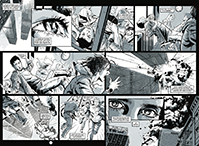
A series of 10 recently published graphic novels discussing genocide takes inspiration partly from the Global Terrorism Database (GTD).
The graphic novels, published by the Dallas Holocaust and Human Rights Museum (DHHRM), draw on material offered by GTD Program Manager Erin Miller. Edward Jacobs of museum design firm Berenbaum Jacobs Associates (BJA) reached out to Miller in December 2016 to discuss how the GTD could contribute to an exhibition.
“We had a phone call and talked about the GTD and challenges with presenting data on terrorism in a way that is accurate and does not promote bias,” Miller said.
One of the graphic novels in the series, titled “[Un]holy War,” features the content that grew out of the conversation between Miller and Jacobs, and follows the story of a high-school age Muslim American boy who grows up to become a journalist reporting on genocidal activity committed by groups such as al-Qaida and ISIS.

“We talked about how the tactics of terrorism are intended to evoke a particular emotional response, and trigger a disproportionate reaction to that attack beyond just the initial im
pact of the attack itself,” Miller said. “We also talked about who the victims of terrorism typically are – the victims of violent jihadist terrorism, for example, are primarily Muslims.”
The DHHRM offers exhibits on the Holocaust, human rights and genocide, and includes a Genocide Gallery that explores the 10 stages of genocide, as outlined by Genocide Watch Founding President Gregory Stanton. The Gallery is comprised of 10 18-foot-high sculptures, each corresponding to different genocidal occurrences as well as a distinct stage of genocidal activity. Instead of standard text panels to transmit the necessary information, the 10 graphic novels were authored by the designers to convey the story of each genocide featured as well as its corresponding stage.
From the outset, the designers of the museum sought to include the relatively new category of genocidal terror into the exhibit. As Holocaust and genocide scholars, BJA has followed START and used its data for many years.
“We were most impressed that Dr. Miller’s first concern was that we were not using this exhibition – or information we may receive from START – to advance a particular political agenda, particularly one of anti-Muslim bias,” Jacobs said. “As educators first and foremost, we wish to enlighten our students and visitors to the complexity of the topic, and its ramifications.”
Jacobs produced the text for the graphic novel that Miller contributed to, and while the characters are fictional, the events are true, and the stories depicted are based on amalgamations of several real people.
“I think it’s a really creative way to present information, particularly to complement a museum exhibition,” Miller said.
Miller noted that such outreach campaigns are a part of a growing trend among museums that recognize that many people may not be able attend their exhibits in person.
“This is a clever and admirable strategy for trying to get the information outside the four walls of the museum,” Miller said.
This is not the first time that information from the GTD has been used in innovative ways. It’s been incorporated into pieces of artwork by multiple artists and used in interactive data visualizations by major news outlets including the New York Times.
“I always enjoy seeing how people are using the GTD in creative ways to reach a different audience than you would typically see accessing information about terrorism,” Miller said. “It’s not just journal articles or news articles that are appropriate and reasonable formats for informing the public.”
Educators can access the graphic novels and other resources on the DHHRM website.
![Opening Page of the graphic novel [Un]Holy War](/sites/default/files/images/GraphicNovelImage_cropped2.png)
